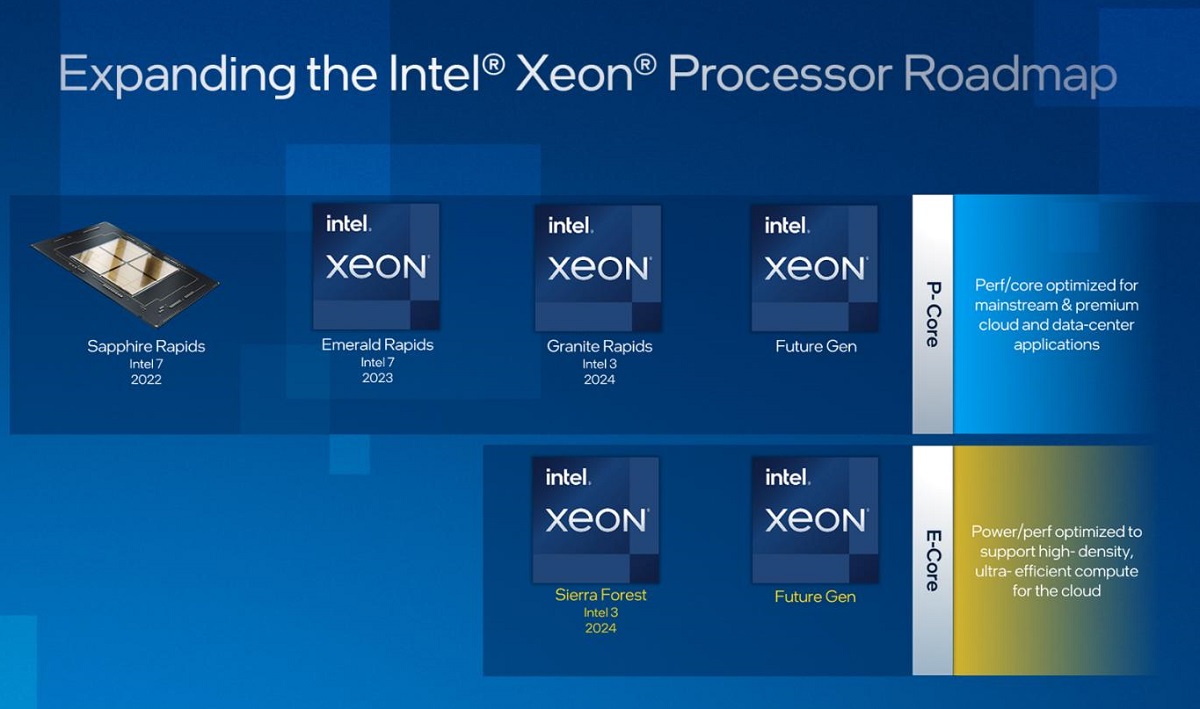After getting bruised in servers by AMD, Intel hopes to stop the bleeding in the server market with next year’s chip offerings.
The difference-making products will be Sierra Forest and Granite Rapids, which are due out in 2024, said Dave Zinsner, chief financial officer at Intel, last week at the Morgan Stanley Technology, Media and Telecom conference.
“We’ll have Emerald [Rapids] out of course, but the real important products that … make a meaningful difference is Sierra Forest and Granite Rapids… in terms of our competitive position,” Zinsner said.
Intel’s current server offering is a Xeon chip codenamed Sapphire Rapids. The chipmaker later this year will ship its successor, codenamed Emerald Rapids, which provides incremental performance upgrades.
Emerald Rapids will be more of a bridge to the difference-making chips released in 2024, but it will not stop the market-share loss the company is taking from AMD.
“We’ll have a falloff in market share in the [2023] first quarter. We are expecting that to stabilize through the year – I would not call that victory. I would call that ‘we’re slowing down the share loss,’” said Dave Zinsner, chief financial officer at Intel, during the Morgan Stanley Technology, Media and Telecom investor conference.
AMD has made the most of Intel’s delays and mismanagement of its server product roadmap, with chips like Sapphire Rapids being delayed multiple times.
Intel’s server market share was 82.4% in the fourth quarter of last year, which fell from a share of 89.3% in the same quarter of 2021, according to numbers from Mercury Research.
AMD’s server market share was 17.6% in the fourth quarter last year, growing from just 10.7% in the same quarter in 2021.
AMD’s next big chip release is Bergamot, which is coming out in the first half of this year. The chip is based on the same instruction set as Genoa, but with more cores and lesser frequency. It is targeted at dense servers.
“It’s optimized for cloud native, so instead of a 96-core cluster, it’s 128 cores. It does not run at the same peak frequency of Genoa,” said Mark Papermaster, AMD’s CTO, also at the Morgan Stanley Tech conference last week.
There are a few reasons why Sierra Forest and Granite Rapids will stabilize Intel’s server offerings, Zinsner said.
“The performance of Granite [Rapids], relative to what customers need, and what the competitors will have, is going to be fantastic,” Zinsner said.
Granite Rapids will have performance cores, or “P” cores, while Sierra Forest will be Intel’s first with the energy-efficient “E” cores. Intel is already mixing up the performance and energy-efficient cores in its PC chips.
The Sierra Forest chip, like Bergamot, is targeted at cloud-native applications.
HPE has touted the need for specialized servers that are power efficient to run cloud-native applications. HPE’s RL300 ProLiant Gen11 Arm server, which runs on Ampere’s Arm-based Altra and Altra Max chips, is targeted at cloud-native applications. HPE opted for Arm as it thought x86 chips were too power hungry and designed to run legacy datacenter applications.

Intel’s Sapphire Rapids’ ongoing ramp comes amid a depressed server market, which is also hurting AMD. Tech companies are cutting budgets, which has slowed down transitions to the current generation of server chips. The cost of servers has also increased at a platform level, and the chipmakers are trying to clear out excess inventory of server chips.
All things considered, “the reception has been quite good on Sapphire Rapids… in certain workloads that actually performs extremely well,” Zinsner said.
Intel will make the Granite Rapids and Sierra Forest chips on the Intel 3 process, which the company says will deliver “a further 18% performance per watt” compared to chips based on Intel 4 process, which itself delivers “approximate 20% increase in transistor performance per watt,” compared to Intel 7, which is used for Sapphire Rapids.
Like Sapphire Rapids, the next-generation Emerald Rapids will be made on Intel 7. Intel will not manufacture server chips on the Intel 4 process, instead which will be used to make PC chips like Meteor Lake, which is due for release later this year.
“We’re onto Intel 3 which is 2024,” Zinsner said, adding “we’re well on our way on ETA” for Intel chips on those process, which include Sierra Forest and Granite Rapids.




























































